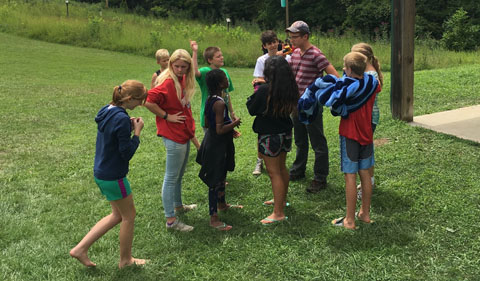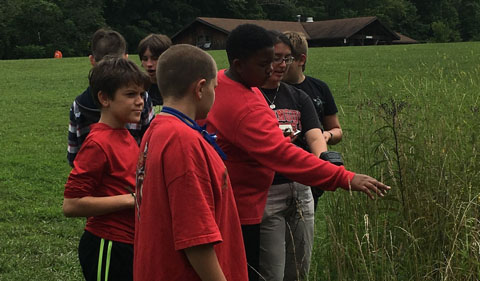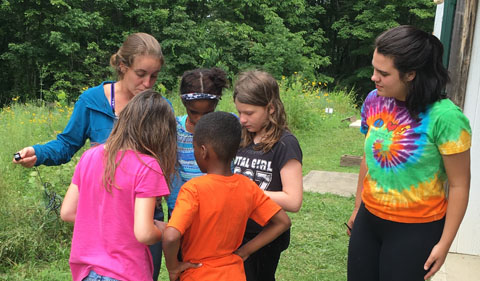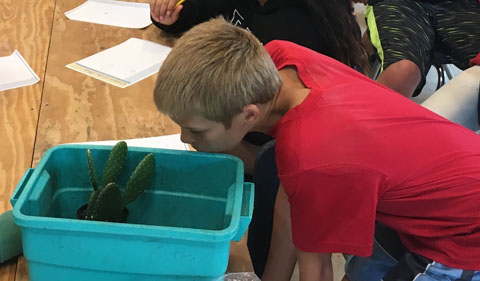
Brett Fredericksen explains how to use a thermal gun to measure infrared radiation (heat).
Graduate students from the of Environmental & Plant Biology Department Graduate Student Association made time this summer to share their knowledge and love of plants with young people at Camp Oty’okwa and Good Works.
These Ohio University students spent much of the summer in the field and lab collecting data for their own research, but they were also eager to share their enthusiasm for science with young people in the community. The children responded with equal energy and interest.
Camp Oty’okwa is a camp run by Big Brothers Big Sisters of Central Ohio and is located in the Hocking Hills area.
Kelsey Bryant, Jen Hastings and Brett Fredericksen, along with Dr. Kim Thompson, helped campers make predictions and collect data on how leaves stay cool in the summer. They also led a walk in an old growth forest so that they could observe different leaf types, measure the amount of light available to plants, and identify plants in the forest. Back at the barn, campers pressed the leaves they had collected.

Jen Hastings asks campers to read a thermal gun directed at plants in the prairie.
Campers were asked, “How do leaves avoid heat and still capture sunlight?” Hands shot up, hypotheses were suggested, and the experiments were begun. The campers used thermal paper cut in the form of leaves of different sizes and shapes to determine how well different types of leaves stay cool and prevent water loss. They also compared open space with shade as well as the effects of wind and rain through simple exercises. Campers interpreted their results and discussed how leaf shape and size might vary depending on its place on a plant relative to the sun or the type of environment in which it lives.

Kelsey Bryant shows campers how to read a light meter to detect how much light is available for photosynthesis in different environments.
A variety of cacti were brought to demonstrate how plants live in the hottest and driest ecosystems. Campers also used a thermal gun to detect how much heat was stored in a leaf compared with in the sky or on the ground. A light sensor showed them differences in quantity of light available for photosynthesis in the forest, in the open and in a shelter. In the forest, they compared leaf shapes and looked for flecks of light coming through the forest while collecting and identifying a variety of plant species.

Campers examined the modified leaves (needles) that help cacti stay cool in the hot, dry desert by reducing water loss.
Also this summer, Good Works invited members of the PBIO GSA and AAUW student chapter to offer activities for children ages 5-12 at Summer Kids Discovery Club.
Hastings and Anne Sternberger helped local youth learn about genetic inheritance by extracting DNA from strawberries. Children were also given the opportunity to feed carnivorous plants – Venus flytraps. Hastings also has been a volunteer for the Good Works Gardens throughout the summer.
Thanks to Al Marietta for the invitation to work with campers at Camp Oty’okwa, to Discovery Club Director Emily Axe, to the David Rosenthal, Art Trese and Harvey Ballard labs for equipment, and to the Plant Biology Greenhouse for providing the cacti and Venus flytraps.



















Comments